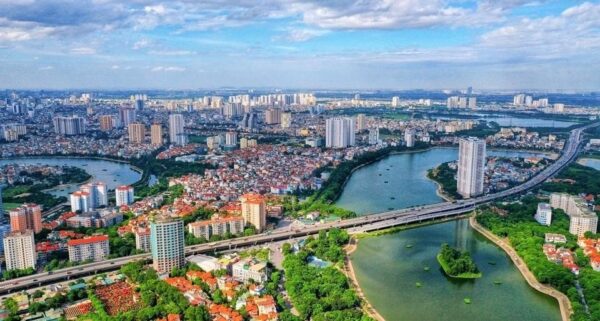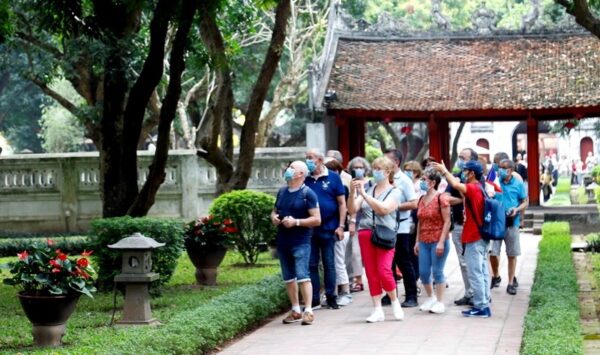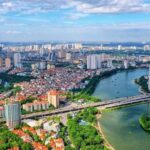Fifteen years after the expansion of its administrative boundaries, the capital city of Hanoi has consistently maintained higher-than-average growth, actively contributing to the national economic upswing. It continues to assert its role and position as the economic hub and driving force for development in the Red River Delta Region and the entire country.
Today, on August 1, Hanoi marks the 15th anniversary since the effective date of Resolution No. 15/2008/QH12, dated May 29, 2008, of the National Assembly, “Adjusting the Administrative Boundaries of Hanoi and Some Related Provinces.” This also commemorates 15 years since Hanoi’s expansion and unification (August 1, 2008 – August 1, 2023). Over these 15 years, the Party Committee, government, military, and people of Hanoi have tirelessly strived to fulfill political tasks, increasingly living up to the capital’s position and role.
Looking at the economic growth figures, we can see that Hanoi has achieved significant results in growth over the 15 years since the city’s administrative boundaries were expanded.
Positive Contribution to National Growth
According to the latest report from the People’s Committee of Hanoi, the city has consistently maintained higher-than-average growth (except in 2018) and actively contributed to the nation’s overall growth. In the period from 2011 to 2022, Hanoi’s GRDP (Gross Regional Domestic Product) increased by 1.12 times compared to the national average growth rate (the country’s growth rate was 5.94% per year).
The scale of Hanoi’s GRDP in 2022 (at constant prices of 2010) reached VND 772.2 trillion, which is 2.17 times higher than that in 2010. Income per capita, calculated based on GRDP, rose to VND 141.8 million (current prices) in 2022 – approximately USD 5,950, 1.45 times higher than the national average (about USD 4,110), and 3.5 – 3.8 times higher than that in 2008 (VND 37.4 million – approximately USD 1,697).
 |
|
Hanoi capital’s landscape transforms swiftly 15 years ater administrative expansion. |
The proportions of service industries and industrial-construction sectors have surged, while the agricultural sector has seen a reduction. Comparing the economic structure of 2011, where services constituted 63%, industry -construction 20%, agriculture 3.6%, and product taxes 13.4%, to that of 2022, we observe a shift in the corresponding structures: 63.22%, 24.04% – an increase of 0.22% and 4.04%, respectively. Agriculture and product taxes have decreased to 2.08% and 10.66%, representing a reduction of 1.52% and 2.74%, respectively.
In 2022, Hanoi’s labor productivity reached VND 291.3 million per worker (current prices), marking a 2.34-fold increase from 2011 (VND 124.5 million per worker) and a 1.6-fold increase compared to the national average (VND 181.1 million per worker).
During the period 2011-2015, Total Factor Productivity (TFP) contributed approximately 36.3% to the GRDP growth (compared to the national figure of 34.1%). In the subsequent period of 2016-2020, Hanoi’s TFP contribution increased to around 46.0% (versus the national figure of 44.4%).
Tourism gradually emerging as the Capital’s economic spearhead
The emphasis on service development in recent years has propelled the restructuring of the internal sectors within the capital city. Notably, the recent focus has been on digitization, the vigorous promotion of e-commerce, and the revitalization of the tourism industry post the Covid-19 pandemic. From 2011 to 2022, services witnessed an average annual growth of 6.77%, surpassing the overall average of 6.67%. In 2022, the service sector rebounded significantly, registering a growth of 10.06%. The first six months of 2023 continued to affirm this recovery trend, achieving a growth rate of 7.54% – 1.26 times the general GDP growth rate (5.97%).
Tourism has been strategically developed and is gradually becoming the focal point of the capital’s economy. In 2019, Hanoi welcomed 21.92 million domestic tourists (1.9 times that of 2011) and 7.02 million international visitors (3.7 times that of 2011). It accounted for over 37% of the country’s international visitors, justifying its role as the largest tourism coordination center in the northern region. Hanoi is ranked among the top 10 cities globally with the fastest-growing tourism and holds the 15th position in the list of the 25 most popular tourist destinations worldwide.
Regarding financial services and banking, significant transformations have occurred within the capital since 2008. Banking technology has undergone a fundamental shift, with financial institutions actively driving digital conversion, interconnecting various industries to expand the digital ecosystem of banking services, and facilitating cashless transactions. Presently, all banks within the region have implemented Internet banking, mobile banking, various types of e-wallets, and expanded card functionalities to cater to the diverse needs of customers.
Financial institutions’ systems continue to be organized, restructured, and synchronously implement solutions regarding mechanisms and policies. There is increased transparency regarding the actual bad debt situation of financial institutions. They maintain secure and transparent payment operations, ensuring the smooth circulation of currency and mobilizing funds to meet the demands of business operations. Nationwide, mobilized capital accounts for approximately 28%, with an average annual growth rate of 17.93%. Credit debt accounts for around 27% nationwide, with an average annual growth rate of 13.9%.
 |
|
Tourism emerging as the pinnacle of the Capital’s economy |
Over the past 15 years, there has been a concerted effort to develop domestic commercial infrastructure, including logistics centers, dry ports, shopping centers, supermarkets, and markets. Currently, Hanoi boasts three logistics centers—Hateco Logistics Center, Yen Vien Station Logistics Center, and the Northern Region Transportation Exploitation Center in Kim Hoa Commune, Me Linh District. Additionally, there are two Inland Container Depots (ICD) in My Dinh (5.2 hectares) and Gia Thuy (1 hectare). The city is aggressively advancing three projects: ICD Co Bi, ICD Duc Thuong, and the Phu Dong International Container Port. The commercial landscape includes 28 shopping centers, 123 supermarkets, 1,840 convenience stores, 493 gas stations, 1,703 LPG bottle retail stores, 415 vending machines, and 16,184 e-commerce applications.
The groundbreaking for the Southern Hanoi Wholesale Market (Bich Hoa Commune, Thanh Oai District) has commenced, and there are plans for an international agricultural wholesale market in Yen Thuong Commune (Gia Lam District). The city is undergoing a transformation in the management, business, and operation models of 164 markets out of a total of 459. Modern payment methods and the robust development of e-commerce, constituting approximately 7.0% of the total retail of goods and services, are evident. The city collaborates with major e-commerce platforms such as Shopee, Tiki, Sendo, and Lazada, actively supporting the consumption of agricultural products for cooperatives and associations in the area. Hanoi maintains its position as the second-largest e-commerce index in the country.
In the period from 2009 to 2022, the average growth rate of export turnover reached 6.68%, while imports increased by 4.16%. The trade surplus, which was 2.35 times the export value in 2008, has now reduced to 1.15 times in the first six months of 2023. In 2022, the total export and import turnover exceeded USD 58 billion, a remarkable 1.93-fold increase compared to the 2008 figure of just over USD 30 billion.
Inflation has been effectively controlled, with efficient management and operation of market-driven prices regulated by the state. The consumer price index dropped from 18% in 2011 to 3.4% in 2022, significantly contributing to stabilizing the macroeconomic situation nationwide.
The industrial sector has undergone positive restructuring, emphasizing the increased proportion of processing, manufacturing, and high-tech development. Industrial zones and clusters continue to develop, featuring nine industrial zones and 70 active clusters. A focus on the knowledge economy and digital economy is evident. Hanoi consistently leads the country in ICT industry revenue, reaching around 320 trillion VND, with approximately 8,500 information technology enterprises and hosting 2/5 of the nation’s concentrated information technology industrial zones. Many high-tech products and smart devices are manufactured in the Hoa Lac High-Tech Zone.
The construction industry has seen an average annual growth rate of 4.14%, with the development of new urban areas shaping a modern urban landscape for the capital, including Viet Hung Urban Area, Vinhomes River Side, VinCity Ocean Park, VinCity Sportia, Garmuda, Royal City, Times City, among others.
The restructuring of the agricultural sector continues to progress. Districts and towns actively convert rice cultivation areas to more profitable crops or combine them with aquaculture, concurrently promoting the application of advanced technologies.
Increase in Domestic Revenue: Over 10% Growth Since 2023
The State Budget revenue in the area from 2008 to the present has consistently exceeded the centrally assigned targets, with total State Budget revenue in the 2008-2022 period reaching VND 2.94 million billion, averaging an impressive 11.5% annual growth. Revenue sources are managed comprehensively and rigorously, showcasing a positive and sustainable shift in the structure of local State Budget revenue. The domestic revenue share has risen from 80.5% in 2008 to a substantial 91.7% in 2023.
 |
|
Significant attention and focus have been placed on administrative reform in the fields of taxation, customs, and treasury. |
The city consistently addresses challenges, expediting the land allocation process for investors and finalizing financial settlements for land use in corresponding projects tied to ongoing Build-Transfer (BT) endeavors. This, in turn, contributes significantly to generating crucial resources for development investments. Simultaneously, administrative reform efforts in taxation, customs, and treasury have been focal points: implementation of electronic tax filing, full electronic tax refunds for exported goods, and investment projects.
Expanding the specialized revenue account network of the State Treasury in Hanoi across commercial banks and diversifying electronic payment methods such as internet banking, ATM cards, and POS card acceptance devices creates convenience for taxpayers, aiding in the swift concentration of State Budget revenue.
Over the 2008-2022 period, the cumulative expenditure of the local budget exceeded VND 937.3 trillion, reflecting an annual average increase of 11.6%. Notably, approximately VND 426.85 trillion, constituting 45.5% of the total local budget expenditure, was directed towards developmental investments, exhibiting an average annual growth of 11.65%. Concurrently, routine expenditures amounted to around VND 498.25 trillion, representing 53.16% of the total local budget, with an annual average growth of 11.95%.
During the same period, the total social development investment mobilized from all sectors reached nearly VND 4.04 million billion, witnessing an annual increase of 11.04%. The structural composition of societal investments underwent a clear transformation. State-owned sectors decreased from 51.0% in 2010 to approximately 34.3%, while non-state sectors experienced rapid growth, rising from 35.3% to around 54.8%.
Societal investment privatization was robust, especially in areas such as water supply, parking facilities, waste treatment, IT infrastructure, education, and healthcare. The cumulative number of registered businesses in the area surpassed 362,000 by the end of June 2023.
To date, Hanoi has attracted over 4,500 new FDI projects, with a total registered capital exceeding 33 billion USD. Beyond technology transfer, skill development for the workforce, and participation in global production networks and value chains, FDI enterprises annually contribute over 10% to the local budget, employ 11% of the workforce, and contribute 11% to the total societal development investment.
The city has diligently devised and executed annual plans to enhance the investment environment, foster business development, and promote investment. Investors, both domestic and international, are gradually instilled with confidence. The Provincial Competitiveness Index (PCI) has seen a continuous rise since 2012, ranking 51 out of 63 initially and surging to an impressive 9th place from 2018 to 2020 among provinces and cities nationwide.
In comparison to the Northern Key Economic Region and the entire country, although Hanoi constitutes only 21.2% and 1% in terms of area, and 41.7% and 8.1% in population respectively, its contributions are substantial. Hanoi contributes 47.46% and 12.59% to the GRDP, 52.48% and 17.07% to state budget revenues, 14.19% and 4.61% to the export turnover, and 29.77% and 10.77% to the import turnover of the Northern Key Economic Region and the nation as a whole.
The capital’s economy rightfully holds a paramount position, acting as the driving force for the development of the Northern Key Economic Region and playing an increasingly pivotal role in the national economy. The rural landscape is undergoing positive transformations toward greater civility and modernity. The construction of new rural areas witnesses active participation from the People’s Committees of districts and direct contributions from the residents. Here, the intrinsic values of traditional culture are preserved and flourishing.
Ha Phong

